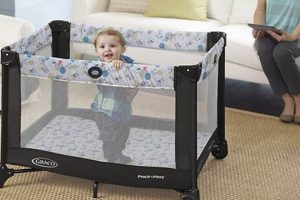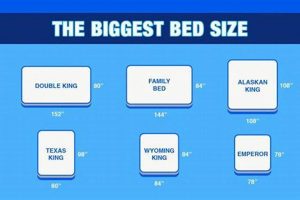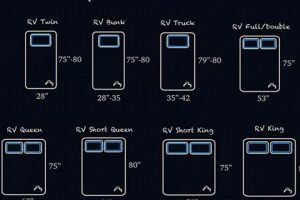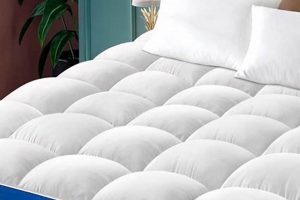A water-filled mattress designed to fit a standard queen-size bed frame offers a unique sleep experience. These mattresses, utilizing water displacement to conform to the body, have been available in various designs, ranging from single-chamber to baffled multi-chamber systems. The size designation indicates dimensions of approximately 60 inches wide by 80 inches long, mirroring standard queen mattress measurements, ensuring compatibility with existing bedroom furniture.
The purported advantage lies in the even distribution of weight, potentially alleviating pressure points and promoting better spinal alignment for some users. Historically, these products gained popularity in the latter half of the 20th century, marketed for their comfort and therapeutic benefits. Despite fluctuations in market share, they remain a viable option for individuals seeking an alternative to traditional innerspring or foam mattresses, offering a distinct sensation of buoyancy and support.
The remainder of this discussion will address construction materials, temperature regulation methods, maintenance procedures, and considerations for individuals with specific health conditions relevant to selecting this type of sleep surface. Durability and compatibility with various bed frames will also be discussed.
Tips for Optimal Usage
The following recommendations are intended to maximize the lifespan and comfort associated with a water-filled mattress designed for a queen-size bed frame. Proper care and maintenance are essential for ensuring optimal performance and preventing potential issues.
Tip 1: Proper Filling is Crucial. Overfilling may stress seams, leading to leaks. Underfilling compromises support. Consult the manufacturer’s instructions for the correct water level. A level should be used to ensure even distribution.
Tip 2: Utilize a Quality Liner. A safety liner positioned beneath the mattress is essential. It acts as a secondary containment measure in the event of a puncture, preventing water damage to flooring and surrounding structures.
Tip 3: Regulate Temperature Consistently. A waterbed heater is required to maintain a comfortable sleep temperature. Monitor the thermostat regularly, especially during seasonal changes, to avoid overheating or excessive cooling, both of which can affect sleep quality and material integrity.
Tip 4: Condition the Water Periodically. Use a waterbed conditioner as directed by the manufacturer. This prevents algae growth and bacterial contamination, extending the lifespan of the bladder and maintaining water quality.
Tip 5: Inspect Regularly for Leaks. Conduct routine visual inspections of the mattress surface and surrounding area for any signs of moisture. Promptly address even minor leaks to prevent further damage.
Tip 6: Use Appropriate Bedding. Heavy blankets can impede heat transfer from the heater, while overly thin sheets may not provide adequate insulation. Select bedding that balances comfort and temperature regulation.
Tip 7: Ensure Proper Frame Support. The bed frame must be designed to support the significant weight of a filled waterbed. Reinforce the frame if necessary, paying particular attention to the center support, to prevent structural failure.
Adhering to these guidelines will help prolong the life of this specialized mattress, ensuring consistent comfort and minimizing the risk of damage. The key is to maintain a balance between proper maintenance and careful handling.
The subsequent sections will delve into common issues, troubleshooting techniques, and comparisons with other mattress types to provide a comprehensive understanding of waterbed ownership.
1. Dimensions
The term “queen size,” when applied to a waterbed mattress, directly dictates its physical dimensions. Standard queen size dimensions are approximately 60 inches in width and 80 inches in length. Deviation from these dimensions renders the mattress incompatible with standard queen-size bed frames and bedding accessories. This dimensional standardization is essential for logistical considerations, allowing consumers to readily integrate the mattress into existing bedroom setups.
Consider the practical ramifications of non-standard dimensions. A mattress slightly larger than standard would not fit the frame, requiring either frame modification or mattress customization. Conversely, a mattress smaller than the standard may shift within the frame, creating discomfort and instability. Furthermore, readily available fitted sheets, mattress protectors, and blankets are designed for standard queen dimensions. Utilizing a non-standard size would necessitate custom-made linens, increasing cost and limiting selection.
The adherence to standard queen size dimensions is therefore crucial for both manufacturers and consumers. It ensures interchangeability, reduces logistical complexities, and simplifies the purchasing process. While custom waterbed mattresses are available, the standard queen size remains the most accessible and cost-effective option for those seeking this particular type of sleep surface. Variations from the standard significantly impact practicality and overall user experience.
2. Construction
The term “construction,” in reference to a queen size waterbed mattress, encompasses the materials, design, and assembly techniques employed in its creation. These factors directly influence the mattress’s durability, comfort, and overall performance. The selection of materials, such as the type of vinyl used for the bladder and the inclusion of internal baffling, determines the mattress’s resistance to punctures, stretching, and the degree of motion transfer experienced by occupants. The design elements, including the number and arrangement of internal baffles, directly impact the distribution of water and the level of support provided to different areas of the body. Poor construction can result in uneven support, leaks, and a reduced lifespan, ultimately negating the potential benefits of a waterbed mattress.
Consider, for example, a queen size waterbed mattress constructed with thin, low-grade vinyl. Such a mattress would be more susceptible to punctures from sharp objects or stress fractures from repeated use. Similarly, a mattress lacking adequate internal baffling would exhibit excessive wave motion, potentially disrupting sleep and causing discomfort. Conversely, a mattress constructed with high-quality, reinforced vinyl and a well-designed baffling system would offer greater durability, improved support, and reduced motion transfer. These construction details differentiate a product offering lasting comfort from one prone to failure. An Example is baffles provide extra support in the lumbar, shoulder and neck areas
Therefore, understanding the construction of a queen size waterbed mattress is essential for making an informed purchasing decision. Consumers should prioritize mattresses constructed with durable materials, robust seams, and effective baffling systems. While price may be a factor, opting for a poorly constructed mattress can result in long-term dissatisfaction and the need for premature replacement. Assessing the construction quality before purchase mitigates risk and ensures a more positive user experience.
3. Weight Distribution
A significant characteristic of a water-filled mattress, particularly one designated as “queen size,” lies in its weight distribution properties. The underlying principle involves hydrostatic pressure: the weight of the occupant is distributed across the entire surface area of the mattress, conforming to the body’s contours. This contrasts with traditional mattresses, where weight is concentrated at pressure points. The result is a reduction in localized stress on bony prominences and improved circulatory flow in those areas. For instance, an individual lying on their side on a conventional mattress experiences concentrated pressure on the hip and shoulder, while a water-filled mattress diffuses that pressure more evenly across the torso.
The effectiveness of weight distribution is directly related to the water volume and internal baffling system within the queen size waterbed mattress. Insufficient water fill compromises the conformity, leading to areas of concentrated pressure. Conversely, overfilling strains the mattress seams and diminishes the support provided. Internal baffles mitigate motion transfer and maintain a more stable surface, preventing excessive sinking in heavier areas of the body. Without these baffles, the weight of the torso, for example, could displace water excessively, causing the extremities to be less supported. This demonstrates the intertwined relationship between weight distribution and construction quality.
In summary, the uniform distribution of weight offered by a water-filled mattress of queen size dimensions represents a distinct advantage for individuals seeking pressure relief and improved sleep comfort. However, achieving optimal weight distribution requires careful attention to proper fill levels, a well-designed internal baffle system, and appropriate maintenance. Failures in these areas compromise the mattress’s ability to deliver its intended benefits, highlighting the need for informed purchasing decisions and consistent care. The implications of this relationship extend to considerations for individuals with specific medical conditions, such as back pain or pressure ulcers, where optimized weight distribution is of paramount importance.
4. Temperature Control
Temperature regulation is an integral component of a queen size waterbed mattress system. Unlike traditional mattresses, a waterbed utilizes a substantial volume of water, which inherently possesses a high thermal mass. This characteristic necessitates an active heating element to maintain a consistent and comfortable sleep temperature. Without controlled heating, the water within the mattress would equilibrate to ambient room temperature, potentially resulting in a cold and uncomfortable sleep surface, particularly in colder climates. A thermostat-controlled heating pad, typically placed beneath the mattress, introduces thermal energy into the water, counteracting heat loss and allowing the user to select a preferred temperature range. This active temperature control distinguishes waterbeds from other mattress types and significantly impacts user satisfaction.
The effectiveness of the temperature control system directly influences the overall sleep experience. For example, individuals with arthritis or fibromyalgia may find the consistent warmth of a heated waterbed beneficial in alleviating joint pain and muscle stiffness. Conversely, inadequate temperature control or a malfunctioning heater can lead to discomfort and disrupt sleep patterns. The size of the waterbed also affects the energy required to maintain a specific temperature. A queen size mattress, with its larger water volume compared to a twin or full-size model, necessitates a more powerful heater to achieve and sustain the desired warmth. Furthermore, the efficiency of the temperature control system is influenced by external factors such as room temperature, insulation, and the use of mattress pads. A well-insulated room reduces heat loss, decreasing the energy required to maintain a consistent mattress temperature.
In conclusion, temperature control is not merely an accessory but a fundamental element in the operation of a queen size waterbed mattress. It directly impacts user comfort, therapeutic benefits, and energy consumption. Effective temperature control requires a reliable heating element, a precise thermostat, and consideration of environmental factors. Understanding the interplay between these elements is crucial for optimizing the performance and longevity of a queen size waterbed mattress system, ensuring a comfortable and restful sleep environment.
5. Maintenance Needs
The long-term viability and consistent performance of a queen size waterbed mattress are intrinsically linked to diligent maintenance practices. Neglecting these needs can lead to premature degradation, diminished comfort, and potential damage to surrounding property. Therefore, a thorough understanding of required upkeep procedures is essential for any owner of this type of sleep system.
- Water Conditioning
The water within the mattress bladder is susceptible to bacterial growth and algae formation. Untreated water can lead to unpleasant odors, discoloration, and eventual degradation of the vinyl. Regular addition of a waterbed conditioner, as per the manufacturer’s instructions, inhibits microbial proliferation and maintains water clarity. This process typically involves adding a specified amount of chemical solution every six months to a year, depending on the product and water quality.
- Leak Prevention and Repair
The integrity of the vinyl bladder is crucial for preventing water leakage. Routine visual inspections of the mattress surface and seams are necessary to identify any signs of punctures, tears, or weakening. Prompt repair of even minor leaks is essential to prevent significant water damage. Repair kits are available and typically involve patching the affected area with vinyl adhesive. A safety liner placed beneath the mattress provides an additional layer of protection in case of undetected leaks.
- Temperature Regulation System Maintenance
The heating system requires periodic inspection and maintenance to ensure proper functionality. The thermostat should be checked for accuracy and recalibrated if necessary. The heating pad itself should be inspected for signs of wear, such as fraying wires or discoloration. Inconsistent temperature regulation can indicate a malfunction requiring professional repair or replacement of the heating element. Proper grounding of the electrical components is crucial for safety.
- Frame and Support Structure Inspection
The bed frame supporting the queen size waterbed mattress must be structurally sound to handle the significant weight of the filled bladder. Regular inspection of the frame, particularly the center support, is necessary to identify any signs of weakening or damage. Reinforcements may be required to prevent frame collapse. A stable and level frame ensures even weight distribution and prevents undue stress on the mattress seams.
In summary, maintaining a queen size waterbed mattress involves a multifaceted approach encompassing water quality management, leak prevention, temperature control system upkeep, and structural integrity assessments. These practices are not merely optional but are essential for preserving the longevity, comfort, and safety associated with this type of sleep system. Failure to adhere to these maintenance needs can result in significant financial costs and potential inconvenience.
6. Frame Compatibility
Frame compatibility constitutes a critical consideration when integrating a queen size waterbed mattress into a bedroom environment. The unique weight and dimensional characteristics of this mattress type necessitate careful evaluation of the supporting structure. A frame designed for traditional mattresses may lack the necessary reinforcement to adequately support the significant mass of a filled waterbed, leading to potential structural failure and consequential damage.
- Weight-Bearing Capacity
A primary concern involves the frame’s ability to withstand the weight of the water-filled mattress. A queen size waterbed can weigh upwards of 1200 pounds when filled. Frames lacking sufficient reinforcement, particularly along the central support structure, are prone to collapse or deformation. Reinforcing the frame with additional support beams or metal brackets is often necessary to ensure stability and prevent structural failure. This is especially true for older frames or those constructed from weaker materials.
- Dimensional Accuracy
The frame must accurately conform to the dimensions of a standard queen size mattress (approximately 60 inches wide by 80 inches long). Deviations from these dimensions can result in improper mattress fit, leading to discomfort and potential damage to the mattress itself. An oversized frame may allow the mattress to shift, while an undersized frame may compress the mattress, compromising its structural integrity and potentially leading to leaks. Accurate measurement and frame selection are crucial to ensure a proper fit.
- Edge Support and Containment
Traditional bed frames often rely on recessed edges to contain a standard mattress. Waterbed frames, however, typically require a solid, flat surface or a specifically designed lip to fully support the perimeter of the mattress. Inadequate edge support can lead to sagging and uneven weight distribution, reducing comfort and potentially damaging the mattress seams. Solid platform frames or frames designed specifically for waterbeds are recommended to provide adequate edge support and containment.
- Waterbed-Specific Frame Designs
Several manufacturers offer bed frames specifically designed for waterbeds. These frames incorporate reinforced support structures, accurate dimensions, and appropriate edge support mechanisms. Some designs also include features such as built-in drawers or shelving, optimizing space utilization. While potentially more expensive than generic frames, waterbed-specific designs offer enhanced stability, durability, and compatibility, ultimately prolonging the lifespan of the mattress and improving the overall sleep experience.
The preceding considerations underscore the importance of meticulous frame selection when installing a queen size waterbed mattress. Failure to adequately address weight-bearing capacity, dimensional accuracy, edge support, and design compatibility can result in structural damage, reduced comfort, and a shortened mattress lifespan. Prioritizing frame compatibility ensures a safe, stable, and comfortable sleep environment.
Frequently Asked Questions Regarding Queen Size Waterbed Mattresses
The following questions and answers address common concerns and misconceptions associated with the use and maintenance of queen size waterbed mattresses.
Question 1: What is the expected lifespan of a water-filled mattress of queen dimensions?
The lifespan varies significantly based on construction quality, maintenance practices, and usage patterns. A well-maintained mattress constructed from durable materials can last for 10 years or more. However, neglect of maintenance or exposure to harsh conditions can shorten the lifespan considerably.
Question 2: How much does a filled queen size waterbed mattress weigh?
The weight depends on the internal construction and water capacity. A fully filled queen size waterbed mattress typically weighs between 1200 and 1600 pounds. This weight necessitates a robust and properly supported bed frame.
Question 3: What type of bed frame is required for supporting a queen size waterbed mattress?
A specialized waterbed frame or a heavily reinforced traditional frame is necessary. The frame must provide adequate support across the entire mattress surface, particularly along the center. Failure to use a suitable frame can result in structural damage and potential water leakage.
Question 4: How often does the water in a queen size waterbed mattress need to be changed?
The water does not typically require changing. Instead, a waterbed conditioner should be added periodically (usually every 6 to 12 months) to inhibit bacterial growth and maintain water quality. Draining and refilling the mattress is only necessary in cases of contamination or significant damage.
Question 5: What are the common causes of leaks in water-filled mattresses?
Leaks can result from punctures by sharp objects, stress fractures due to age and use, or degradation of the vinyl material. Proper maintenance, including the use of a mattress protector and avoidance of sharp objects, can help prevent leaks.
Question 6: Is a queen size waterbed mattress suitable for individuals with back pain?
Some individuals with back pain find relief from the even weight distribution offered by a waterbed mattress. However, the suitability varies from person to person. Consulting a healthcare professional is recommended before making a decision, as individual needs and conditions differ significantly.
These FAQs provide a foundational understanding of waterbed ownership. Careful consideration of these factors is recommended before purchasing this type of mattress.
The next section will explore the potential benefits and drawbacks compared to traditional mattresses.
Conclusion
The preceding exploration has presented a detailed overview of the queen size waterbed mattress, encompassing its construction, maintenance, and practical considerations. Factors such as weight distribution, temperature control, and frame compatibility are critical determinants of its suitability. Understanding these elements is paramount for consumers considering this type of sleep surface.
The informed evaluation of individual needs and the diligent application of recommended maintenance procedures remain essential for maximizing the longevity and realizing the potential benefits of a queen size waterbed mattress. Further research into specific models and consultation with experienced retailers are encouraged prior to purchase.







